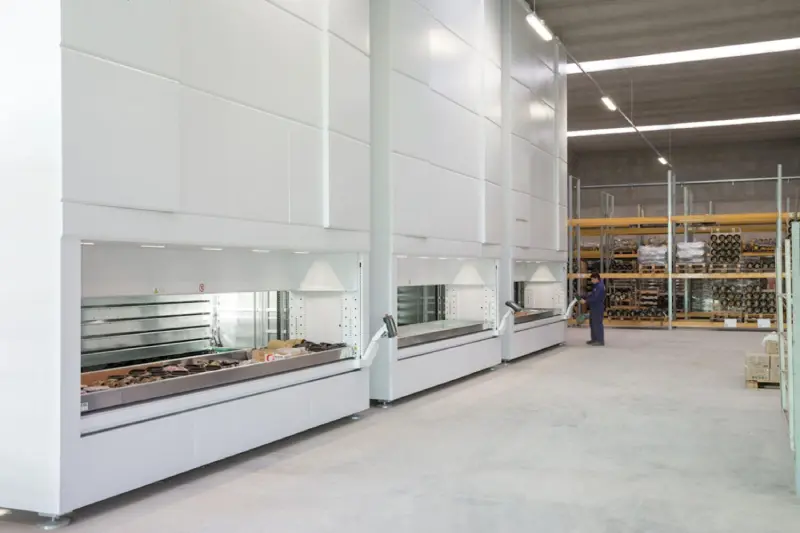

In modern business, optimizing warehouse processes plays a key role in increasing efficiency and reducing costs. Automated vertical storage warehouses are an innovative solution that allows for the maximum use of available space and the automation of storage and retrieval processes.
Advantages of Automated Vertical Storage Warehouses
1. Maximum Space Utilization:
Vertical warehouses significantly increase storage volume by using the height of the premises. This is particularly relevant for enterprises with limited warehouse space.
2. High Speed and Accuracy:
Automated systems provide fast and accurate retrieval of goods. This reduces order processing time and minimizes the risk of errors associated with manual handling.
3. Labor Cost Reduction:
Automation of processes reduces the need for manual labor, lowering personnel costs and increasing overall productivity.
4. Enhanced Safety:
Automated storage systems ensure a high level of safety for personnel by minimizing the need to work at heights and reducing the risk of accidents.
5. ERP System Integration:
Modern automated warehouses can integrate with ERP systems, allowing for real-time inventory tracking and optimized inventory management.
How Do Automated Vertical Storage Warehouses Work?
Automated vertical storage warehouses use a system of lift platforms that move goods to the desired storage level and back. The system is controlled by software that allows setting storage and retrieval parameters, as well as tracking all operations in real time.
Applications of Automated Vertical Storage Warehouses
– Manufacturing enterprises: Optimizing warehouse processes and reducing logistics costs.
– Logistics centers: Increasing throughput capacity and improving inventory management.
– Retail companies: Increasing order processing speed and improving customer service.
Automated vertical storage warehouses represent an advanced solution for businesses striving for maximum efficiency and resource savings. Implementing such systems not only optimizes warehouse processes but also improves overall enterprise productivity.
Specifications:
| Model | Tray width, mm | Tray depth, mm | Maximum tray loading height, mm | Maximum tray load, kg |
| TL-1900 | 1900 | 650 | 600 | 500 |
| TL-2500 | 2500 | 650 | 600 | 500 |
| TL-3100 | 3100 | 650 | 600 | 500 |
| TL-3500 | 3500 | 650 | 600 | 500 |
| TL-4100 | 4100 | 650 | 600 | 750 |
Additional Options:
Storage Organization:
- Perforated, sectioned, adjustable trays
- Compartments with dividers, baskets, tool holders
- Storage location identification with LED indicators (Pick-to-Light / Put-to-Light)
Automation and Integration:
- Integration with industrial robots (automated loading/unloading)
- Compatibility with barcode, RFID, and QR scanning systems
- Cameras for operation logging and control
Security:
- Multi-level access system (PIN, card, biometrics)
- Safety light curtains and emergency stop systems
- Weight and volume monitoring for loaded items
Software:
- Advanced software for inventory tracking and analysis
- Remote monitoring (via cloud)
- Mobile app for smartphone/tablet management
Environmental Options:
- Temperature and/or humidity control (for storing medications, electronics, etc.)
- Dust- and moisture-resistant design (IP65 and above)
Installation and Structural Options:
- Built-in wall/floor integration
- Outdoor installation with insulated enclosure
- Vandal-resistant version
Service and Support:
- Warranty and post-warranty maintenance
- Remote diagnostics
- Spare parts supply and staff training
